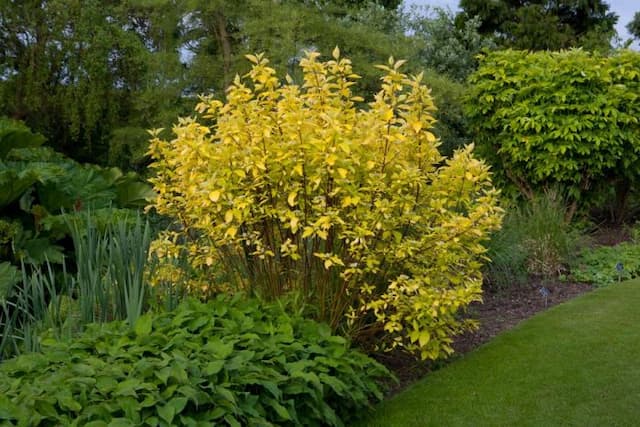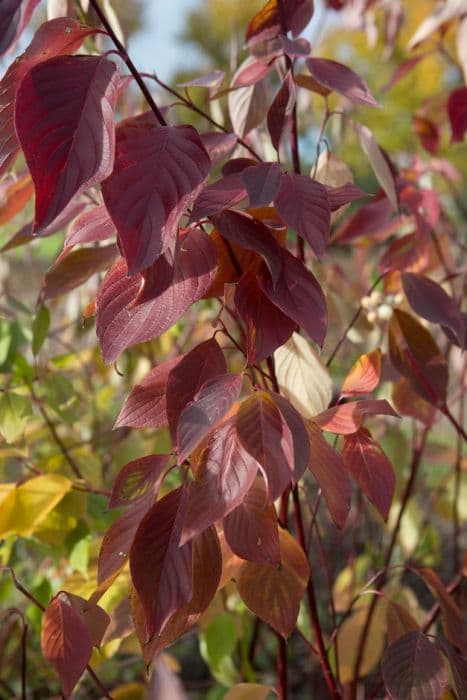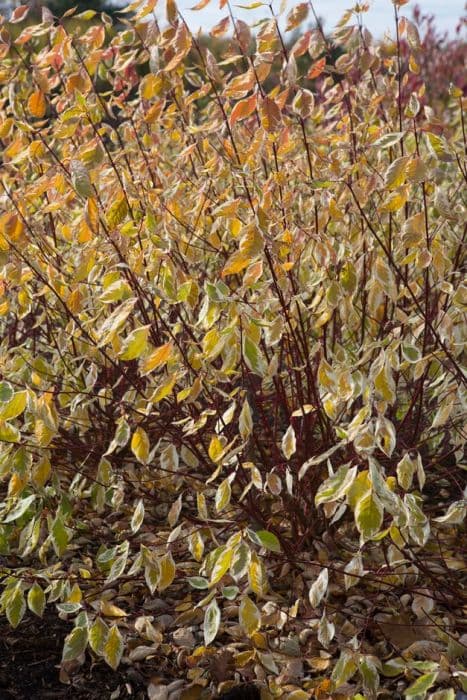Bloodtwig Dogwood Cornus sanguinea 'Midwinter Fire'











ABOUT
The plant commonly known as Midwinter Fire is a striking ornamental shrub recognized for its distinctive stem coloration, particularly during the colder months when many plants lose their vibrancy. As the green leaves of spring and summer fall away, the true spectacle begins. The stems transition from a warm yellow at the base to fiery shades of orange, and eventually deep red at the tips, resembling a flame. Apart from its spectacular winter stem display, this plant bears ovate leaves that are green during the growing season and can turn shades of yellow and orange before they drop in the fall. In late spring to early summer, the plant is adorned with clusters of creamy-white flowers, which are small and inconspicuous, yet they attract pollinators to the garden. Following the flowering period, the Midwinter Fire may produce small blue-black berries that can attract birds and other wildlife. The visual interest provided by Midwinter Fire makes it a beloved choice for gardens that wish to maintain year-round appeal. It is commonly used as a focal point during the winter months when the fiery stems stand out against a dull landscape, often contrasting beautifully with snow or evergreens. The plant provides a natural and colorful display, invoking the warmth of a fire amidst the chill of winter without the need for elaborate maintenance or care.
About this plant
 Names
NamesFamily
Cornaceae
Synonyms
Bloodtwig Dogwood, Winter Flame, Midwinter Fire
Common names
Cornus sanguinea 'Midwinter Fire'.
 Toxicity
ToxicityTo humans
The plant commonly known as Bloodtwig Dogwood is not typically listed as a highly toxic plant to humans. However, like many plants, parts of it may contain compounds that are irritating to the skin or gastrointestinal tract. When ingested, parts of the Bloodtwig Dogwood might cause minor symptoms like nausea, vomiting, or diarrhea. Even though the risk of severe poisoning is low, it is advisable to refrain from consuming any part of the plant, as individual sensitivities can vary.
To pets
Bloodtwig Dogwood is generally not highly poisonous to pets. Nonetheless, if pets consume parts of this plant, they might experience mild gastrointestinal upset, which could include symptoms like vomiting or diarrhea. As with humans, severe toxicity is unusual, but it is best to prevent pets from ingesting the plant to avoid any potential discomfort or more serious reactions depending on the individual animal's sensitivity.
 Characteristics
CharacteristicsLife cycle
Perennials
Foliage type
Deciduous
Color of leaves
Green
Flower color
White
Height
5 feet (1.5 meters)
Spread
5 feet (1.5 meters)
Plant type
Shrub
Hardiness zones
5
Native area
Europe
Benefits
 General Benefits
General Benefits- Attractive Winter Color: As implied by the name 'Midwinter Fire', this cultivar offers striking orange-yellow stems which add warmth to the winter landscape.
- Year-Round Interest: Features a variety of appealing characteristics throughout all seasons, including white flowers in spring and blue-tinted fruit often lasting into winter.
- Erosion Control: Its dense root system helps prevent soil erosion, making it suitable for planting on slopes or in areas prone to erosion.
- Wildlife Habitat: Provides sustenance for birds and pollinators, as it produces flowers and fruits that attract them.
- Low Maintenance: Requires minimal care once established, making it ideal for gardeners seeking plants with ease of upkeep.
- Versatile Landscaping: Can be used in a variety of garden designs, such as in shrub borders, as a specimen plant, or even in mass plantings for greater impact.
- Tolerant: Exhibits tolerance to a range of soil conditions and is relatively resistant to most pests and diseases.
- Seasonal Pruning: Responds well to hard pruning in early spring, which encourages the vibrant stem coloration for which it is known.
 Medical Properties
Medical PropertiesThis plant is not used for medical purposes.
 Air-purifying Qualities
Air-purifying QualitiesThis plant is not specifically known for air purifying qualities.
 Other Uses
Other Uses- Dye Production: The bark of the Midwinter Fire dogwood can be used to create natural dyes in varying shades of brown and beige for textiles and craft projects.
- Winter Interest: Its colorful stems provide a striking visual contrast in a bleak winter landscape, which can be beneficial for winter photography or garden aesthetics.
- Insect Shelter: The dense branching can offer shelter and breeding grounds for beneficial insects during the colder months.
- Basketry: The flexible young shoots can be harvested and used in the craft of basket weaving.
- Culinary Garnish: While not a common use, the bright red stems can be used as a garnish for winter-themed dishes and cocktails to add a pop of color.
- Soil Stabilization: The roots of Midwinter Fire dogwood can help to prevent soil erosion on slopes due to their spreading nature.
- Aquatic Ornamentation: Branches can be partially submerged in water features like ponds to provide interesting shapes and support for aquatic plants.
- Artistic Medium: Dried branches can be used as part of sculptural pieces or installations by artists, especially those who incorporate natural elements into their work.
- Crafting Walking Sticks: Older, sturdier stems can be harvested and crafted into unique, rustic walking sticks.
- Wildlife Aid: The plant can provide sustenance in the form of berries for birds during scarce winter months, and the dense foliage is ideal for nesting sites.
Interesting Facts
 Feng Shui
Feng ShuiThe Bloodtwig Dogwood is not used in Feng Shui practice.
 Zodiac Sign Compitability
Zodiac Sign CompitabilityThe Bloodtwig Dogwood is not used in astrology practice.
 Plant Symbolism
Plant Symbolism- Transformation: 'Midwinter Fire' is known for its bright winter stems that stand out against the cold, symbolizing change and vibrancy in the face of adversity.
- Protection: Cornelian Cherry, as this plant is commonly known, has been traditionally used to ward off evil and is seen as a protector.
- Vitality: The plant's vibrant fire-like stems in the dormant season represent enduring energy and life force within apparent stillness.
- Hope: Its early spring flowers signal the end of winter and the beginning of a new cycle, embodying hope and renewal.
- Purity: The white flowers of the Cornelian Cherry are often associated with purity and innocence.
 Water
WaterBloodtwig Dogwood prefers consistently moist soil, so watering should be done when the top inch of soil feels dry to the touch. Generally, you might water this plant once a week, providing about 1-2 gallons of water each time, depending on the weather conditions and soil type. During the growing season in spring and summer, the frequency of watering may increase, especially if there are prolonged periods of dry or hot weather. In winter, reduce watering as the plant goes dormant. Always ensure proper drainage to prevent waterlogging as this can lead to root rot.
 Light
LightBloodtwig Dogwood thrives in areas with full sun to partial shade. Ideally, it should receive at least four hours of direct sunlight daily but can also benefit from the filtered sun under light canopies of taller trees. An eastern or western exposure that offers morning or late afternoon sunlight is good for promoting healthy growth and vibrant stem color.
 Temperature
TemperatureBloodtwig Dogwood can handle a range of temperatures and is quite hardy, generally capable of withstanding winter lows down to -20°F and summer highs up to 90°F. The ideal growing conditions for this shrub are in USDA hardiness zones 4 through 7. In extreme temperatures, the plant may require additional mulch to protect its roots or water to prevent heat stress.
 Pruning
PruningTo maintain shape and encourage vibrant stem colors, Bloodtwig Dogwood should be pruned in late winter or early spring before new growth starts. Remove about a third of the old stems each year, cutting back to a well-placed bud or branch. This selective thinning promotes vigorous growth and enhances the distinctive winter stem coloration which the plant is known for. Regular pruning also ensures the plant remains healthy and free of any dead or diseased wood.
 Cleaning
CleaningAs needed
 Soil
SoilBloodtwig dogwood prefers well-drained, fertile soil with a pH of 5.5 to 7.5. For the best soil mix, combine two parts garden soil, one part compost or well-rotted manure, and one part sand or perlite to improve drainage.
 Repotting
RepottingBloodtwig dogwood is typically a landscape plant and doesn't require repotting. It is usually planted directly in the ground rather than in containers.
 Humidity & Misting
Humidity & MistingBloodtwig dogwood thrives in average outdoor humidity levels and does not require specific humidity conditions.
 Suitable locations
Suitable locationsIndoor
Place Bloodtwig dogwood near a sunny window and keep the soil moist.
Outdoor
Plant in well-drained soil, full sun to partial shade, water regularly.
Hardiness zone
4-7 USDA
 Life cycle
Life cycleThe 'Midwinter Fire' dogwood (Cornus sanguinea 'Midwinter Fire') begins its life cycle when a seed germinates in early spring, under suitable conditions of moisture and temperature. The seedling grows through the spring and summer, developing into a young plant with characteristic green foliage. As the plant matures, it undergoes vegetative growth, producing stems, leaves, and a root system; this stage can last for several years as the shrub increases in size and strength. During spring, the mature 'Midwinter Fire' dogwood produces small white flowers which are followed by the formation of small black fruits (drupes) that are dispersed by animals, allowing for seed dispersal and potential plant propagation. In autumn, the leaves turn to vibrant shades of yellow, orange, and red before falling off, and the stems transition to their notable bright orange-red to yellow color that persists through the winter, giving the plant its 'Midwinter Fire' namesake. As a perennial, the life cycle repeats annually, with the plant entering a period of dormancy over the winter before resuming growth in the spring.
 Propogation
PropogationPropogation time
Early Spring
Propogation: The most popular method of propagating Cornus sanguinea 'Midwinter Fire', commonly known as the Bloodtwig Dogwood, is through hardwood cuttings. This propagation technique is typically performed in late fall or early winter, after the plant has gone dormant and shed its leaves. To propagate, you take cuttings about 6 to 9 inches (15 to 23 centimeters) in length from healthy, mature stems. The cuttings should have several nodes present, which are the points where leaves attach to the stem, as these will be where new roots are most likely to form. The bottom end of each cutting is dipped in rooting hormone to encourage root development and then placed in a mixture of sand and peat or a well-draining potting mix. Finally, the cuttings are kept in a cool, moist environment until they've rooted sufficiently, which can take several months. Once rooted, the new plants can be potted up individually or planted out in the garden.

![Dogwood [Baton Rouge]](/_next/image?url=https%3A%2F%2Fplants-admin.emdemapps.com%2Fimages%2Fplants%2F%2Fimages%2F604b59cf0fefd.png&w=640&q=75)


![Dogwood [Ivory Halo]](/_next/image?url=https%3A%2F%2Fplants-admin.emdemapps.com%2Fimages%2Fplants%2F%2Fimages%2F604b535cbcb9a.png&w=640&q=75)




